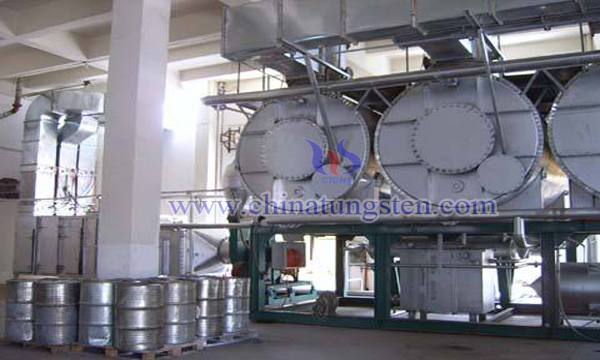Synthesis Of Ethyl Acetate Using Phosphotungstic Acid Catalyst
- Details
- Category: Tungsten Information
- Published on Thursday, 30 May 2019 13:33
Ethyl acetate is a widely-used fine chemical product widely used in cellulose acetate, ethyl cellulose, chlorinated rubber, vinyl resin, cellulose acetate, synthetic rubber, paints.Traditionally, the esterification catalytic reaction of ethyl acetate is generally by using an acid as a catalyst. In addition to the conventional inorganic acid, there is also a solid super acid such as a mesoporous material.
The inorganic acid catalyst has serious corrosion to the instrument, and the homogeneous catalytic product is difficult to separate, and it tends to produce pollutants such as waste acid waste liquid; the solid acid also has the disadvantage of serious corrosion to the instrument, and the catalytic activity is reduced rapidly and the cost is high. The industry believes that if the mesoporous material is used as a carrier to support a homogeneous catalyst, the corrosion of the instrument can be avoided, and the catalyst can easily separate the catalyst from the product, and can be recycled and reused.

Based on the serious corrosion of the equipment and the complicated process of the inorganic acid catalyst, the researchers used a supported phosphotungstic acid catalyst for the synthesis of ethyl acetate. The process includes:
2.0 g of P123 and 15 g of N,N-dimethylformamide (DMF) are added to a solution of 11.2 g of 37% hydrochloric acid and 64 ml of water, and stirred until P123 is completely dissolved; then 4.45 g of tetraethyl orthosilicate is added. Adding to the above solution and stirring at a temperature of 40 ° C for 24 hours at a mechanical stirring rate of 350 r / min; transferring the resulting solution to a reaction vessel of a polytetrafluoroethylene liner, crystallization after being incubated at 100 ° C for 24 hours After washing and drying, the original powder of the doughnut-shaped mesoporous material is obtained; the original powder of the doughnut-shaped mesoporous material is calcined in a muffle furnace at 600 ° C for 24 hours, and the template is removed to obtain a bag-shaped mesoporous dioxide for removing the template. Silicon (MBQ).
1 g of bag-shaped mesoporous silica MBQ was placed in a 100 ml ball mill tank at room temperature with 1 gram of phosphotungstic acid. The ball mill and the grinding ball were made of polytetrafluoroethylene, and the diameter of the grinding ball was 3 mm. The number is one and the rotation speed is 400r/min. The ball mill can be closed and ball milled in a ball mill at a temperature of 60 ° C for 1 hour to obtain 2 g of a target product supported phosphotungstic acid catalyst, the content of phosphotungstic acid is 50% by weight, and the content of the doughnut-shaped mesoporous silica carrier is 50% by weight.
The phosphotungstic acid catalyst was vacuum dried at 150 ° C for 6 hours, and after cooling to room temperature, 4 g was weighed, and 46 g of ethanol and 60 g of acetic acid were weighed together and placed in a 100 ml three-necked flask, and a condenser was added thereto. The mixture was stirred under heating and refluxing at 100 ° C for 4 hours, cooled to room temperature, centrifuged, and the liquid component of the reaction product was analyzed by gas chromatography. The result was: ethyl acetate selectivity of 100%, acetic acid conversion of 87%, catalysis The performance is good, the side reaction is small, and the equipment is not corroded, and can be repeatedly used after being recycled.
- Tungsten Manufacturer & Supplier, Chinatungsten Online: www.chinatungsten.com
- Tungsten News & Prices of China Tungsten Industry Association: www.ctia.com.cn
- Molybdenum News & Price: news.molybdenum.com.cn
- Tel.: 86 592 5129696; Fax: 86 592 5129797; Email: sales@chinatungsten.com



 sales@chinatungsten.com
sales@chinatungsten.com